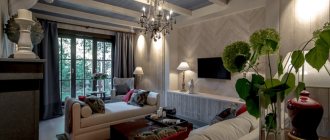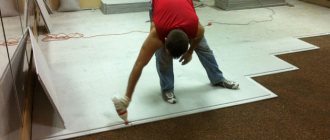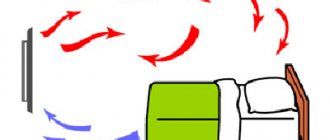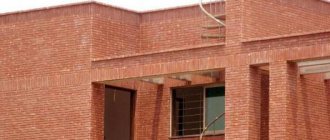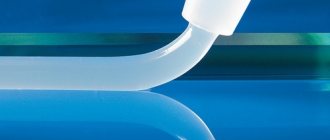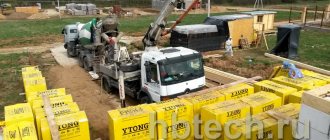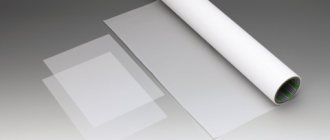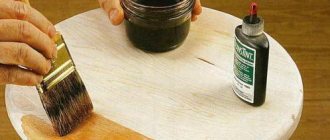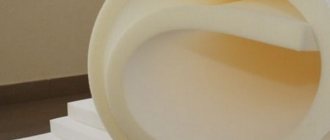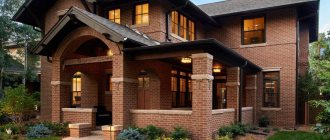Real estate
00:00, 02/24/2021 3 Plot: House in focus
What should a brick be like and where to go for its characteristics
Photo: nedvio.com
The brick house is considered a “classic of the construction genre”, popular for many centuries. It is warm and durable, fire-resistant and respectable-looking. Of course, brick houses have their drawbacks - they are heavy (they will require a serious foundation), require a qualified team (just like any other house), and are not cheap. But there are always hunters for brick cottages, and in large numbers. Today we will discuss the main document describing the properties of ceramic bricks - the state standard for it.
For different tasks
Ceramic bricks can be of several types depending on the type of use. Each of them is suitable only for performing a specific, specific task. Here are the main types of ceramic bricks.
- Construction (aka private). It is intended, in fact, for construction. The main masonry of the house is made from it.
- Facing (aka front) brick is characterized by an even, uniform color, has a smooth texture, and, as a rule, voids are made inside it to improve the thermal insulation of the building. This type of brick is used for cladding buildings and structures; walls cannot be laid from it.
- Fireclay brick is famous for its heat resistance and fire resistance. It can withstand temperatures of more than 1000 degrees Celsius. And it is intended for laying stoves, fireplaces and chimneys.
Thus, the choice of brick depends on what task you are going to assign to it. You cannot replace one type with another; you must use them strictly for their intended purpose.
Photo: stroyres.net
Area of use
The building material is widely used for the construction of foundations, lower floors and other load-bearing structures. Most often it is used to cover facades, interior spaces, basements, construct columns and fences (fences, high borders), decorate windows and create door openings, construct gazebos, stoves and fireplaces. The high hardness of hyperpressed brick makes it possible to use it for the construction of buildings in seismically dangerous regions, in areas where landslides, tornadoes, hurricanes, etc. often occur. Hyperpressed bricks are used for the construction of hazardous industrial facilities.
Dimensions, shapes and definitions
The general characteristics of ceramic bricks or stone are regulated by GOST 530-2012. This standard applies to ceramic bricks and stone for masonry and wall cladding, as well as clinker bricks. Bricks for paving roads (there are some) are not covered by this document.
First, some definitions.
- Standard brick sizes: normal (single) format is 250x120x65 mm. There are also one-and-a-half bricks (with a thickness of 88 mm) and double bricks (with a thickness of 138 mm).
- If the brick has the shape NOT of a rectangular parallelepiped, but some other shape, it is called shaped.
- Solid brick has no more than 13% voids in its composition, hollow brick - accordingly, more.
- The largest side of the brick is called the bed. This is the side that runs parallel to the masonry. The long side is called the spoon, and the short “end” is called the poke.
GOST classifies brick according to various indicators. We have already understood that such products can be regular or front, solid or hollow - this is all spelled out in the standard. And then digital classifications begin: by strength, by frost resistance, by average density, by thermal characteristics and, of course, by size.
Clear standards for deviations from geometric dimensions (a few millimeters) and from the perpendicularity of edges (3 mm) are also established. In a word, GOST establishes very clear descriptions of what a brick can be.
Photo: srbu.ru
Varieties
According to their design, hyperpressed bricks are divided into three groups:
- Full-bodied.
- Hollow. Up to 40% technical holes and cracks.
- Lego. This is a subspecies of hollow, which has two protrusions-spikes on the upper edges and two grooves on the lower ones. This lock provides better adhesion of the masonry.
According to its purpose, hyperpress bricks can be ordinary or construction, as well as facing. The latter type has many textures, shapes and colors:
- Yellow smooth "Lithos". With and without beveled corners.
- "Rock". Rough and softer texture.
- Cornice. With smooth curved curves.
- Angular. It has an L-shape for perfect finishing of corners.
- Snickers. A narrow brick with a chipped surface.
- Torn stone.
There are more faults with face bricks
The technical requirements specified in GOST apply to both facing and ordinary bricks. And they are different.
So, for ordinary brick, the drafters of the document are more favorable in terms of appearance: its edges can be smooth or embossed, whatever you like, and not have a single front edge - they are all the same. What difference does it make if the surface of the masonry is still covered with either plaster or facing brick? But the front brick, firstly, must have at least two front faces - a spoon and a butt (this is so that you can lay out a beautiful corner using only one row of bricks). And it can also have a surface textured in various ways. For example, do you know what engobing is? What about shotcrete? And GOST knows.
Efflorescence (stains from mineral salts appearing on the surface of the brick) is acceptable on ordinary brick. On clinker and face products such “flaws” are unforgivable. There are different requirements for swelling: on an ordinary brick, intumescent inclusions can be a maximum of 1% of the area, and on a facing brick - 0.2%.
According to table No. 4, broken corners are not allowed on the facing brick - none at all. And there can’t be any cracks on our decorative friend. And on ordinary products there are no regulations at all for chips up to 1.5 cm in length and cuts up to 4 centimeters in length. And there can be up to 4 cracks on each brick.
The black core of a brick is completely normal; GOST states that it is acceptable. But with regards to polovnyak (when a brick is split into two parts) - it is clear that there are no batches in which not a single brick is broken, GOST tells us that it is allowed no more than 5% of the total volume of the batch.
In a word, the facing brick should be, as they say, beautiful, and the ordinary brick should be a workhorse, its main task is strength and strength.
Photo: srbu.ru
General information about the material
The material is based on a limestone-cement mixture, which forms blocks and obtains its technical characteristics through dry hyper-compression. The material contains approximately 15 percent high-grade cement, 85-92 percent lime (various scraps or waste from the production of ceramic bricks, marble slabs, crushed stone, etc.), as well as 2-7 percent iron oxide pigments, which give the product the necessary appearance.
The very shape of the blocks gave the material the name brick, but in reality we are talking about artificial stone. The material is durable, but is intended not for construction, but for facing work.
Read more about hyperpressing technology
This method of producing finishing materials became possible only with the development of technology. Moistened starting materials are pressed under ultra-high pressure, which brings the fragments of the mixture into contact at the molecular level. As a result, the final product acquires properties that are more suitable for the definition of natural stone rather than brick. High temperatures are not used during the manufacturing process.
After manufacturing, the brick is placed in a steaming chamber, and then gains strength characteristics in warehouse storage and even directly in the masonry in the first months after use. It is also worth noting that at the moment the production technology for such products is not standardized.
Physical properties
But as for the performance characteristics, GOST provides detailed tables that describe the classes of bricks depending on their physical properties. For example, there are 7 classes of average brick density - they are marked as 0.7 (up to 700 kg/cubic m), 0.8 (170-800 kg/cubic m), 1.0 (from 810 to 1000 kg/cubic m m) and further up to 2.4.
The group of bricks according to thermal characteristics is almost the most important indicator. It determines what the thermal conductivity coefficient of dry masonry will be. The lower this coefficient, the warmer the masonry will be (the worse it will transfer heat to the outside). There are 5 groups of ceramic bricks according to thermal characteristics: high efficiency, increased, effective, conditionally effective and ineffective (ordinary).
Brick grade in terms of strength is a scale of 15 steps, from M25 to M1000. The higher the grade, the stronger the brick. This grade is assigned based on the values of compressive and bending strength.
We go further according to GOST. Next comes water absorption, which for brick products (except clinker) should be at least 6.0%. And one more important property for construction is frost resistance. The brick must be frost-resistant and is also marked on this basis. Depending on the brand, it must withstand a certain number of freezing cycles in a water-saturated state. And there should be no visible signs of damage or destruction on it - cracking, peeling, spalling, chipping (except for chipping from lime inclusions). There are 7 grades of frost resistance of brick: at least 25; 35; 50; 75; 100; 200 or 300 cycles of alternating freezing and thawing.
Photo: s-stroyka.ru
Hyperpressed brick: characteristics, composition, production technology
In Russia, hyperpressed bricks have been put into production relatively recently.
In general, this is one of the varieties of concrete products that has found application in facing work. Many modern enterprises already produce bricks using the semi-dry hyperpressing method. The essence of brick production is that a mixture of cement-mineral composition (marble chips, limestone, cement, coloring pigments) with a very small amount of water is pressed under very high pressure. It is the high pressure of the hyperpress that entirely determines the beauty and completeness of the outer surface of the brick. The technology for the production of hyperpressed bricks is much simpler compared to traditional technologies for the production of sand-lime and ceramic bricks, does not require expensive equipment and consists of the following technological stages (Fig. 1):
- preparation of raw materials (aggregate);
- dosing of components;
- preparation of molding mass;
- pressing;
- strength set;
- brick splitting area.
Raw materials for the production of hyperpressed bricks
The main raw material for the production of hyperpressed bricks is the screening of crushed limestone - the smallest fraction obtained in the production of crushed stone. Dolomite, shell rock (tyrsa), marble chips, stone sawing waste, waste from ore and coal enrichment (heap waste heaps), various slags, etc. can also be used as filler.
Rice. 1. Scheme of the production process of hyperpressed bricks: 1 - hyperpress; 2 — two-hose mixture distributor; 3 - belt conveyor; 4 — forced concrete mixer; 5 — cement dispenser; 6 — screw conveyor; 7 - silo for cement; 8 — belt feeder; 9 — inert bunker; 10 — belt conveyor; 11 — beam crane; 12 - primary bunker of inert materials
You can add crushed rejects and scrap bricks, concrete products and blocks, and expanded clay chips to the raw material mixture. Filler fraction 0-5 mm. If the aggregate is of a larger fraction, then crushing and sorting equipment is installed directly into the production line of hyperpressed bricks to grind and distribute the raw materials into fractions.
The share of filler in the composition of raw materials is 85-93%, cement M500, M600 7-15%, dye 0.5-2% (on average 1%). The dye used is mainly powdered iron oxide pigments produced in Spain, Germany, the Czech Republic, China, and Russia.
Technology for the production of hyperpressed bricks
Next, during the production of hyperpressed bricks, the dosed components of the molding sand enter the mixer for mixing. To obtain a high degree of homogeneity of the mixture, dry mixing is first carried out, and then, if necessary, water is added. The finished mixture enters the hopper of the brick molding press.
A brick hyperpress presses two or three bricks simultaneously in automatic (or semi-automatic) mode. With the simplest readjustment of a brick press, it is possible to produce single or one-and-a-half bricks, solid or with voids.
The molded brick is removed from the press table and placed on a technological pallet. The strength of freshly molded bricks allows you to gain a height of 10 rows.
The technology for producing hyper-pressed bricks requires that raw bricks must go through a stage of strength gain. The hardening process of brick occurs due to the cement hydration reaction, which can occur both in natural conditions at a positive ambient temperature, and accelerated in a steam-air environment at a temperature of 80°C. In the first case, the brick is kept for 28 days at a temperature of at least 20°C. This technique is especially effective in the summer when covering pallets with bricks with film.
In the second case, it is necessary to equip special heat-moisture treatment chambers (HMT), where the brick is steamed under the influence of steam at high temperatures for 8-12 hours. After this, the brick is transported to the warehouse. The hyperpressed brick that has gained strength (at least 70% of the design grade) is transferred to a transport pallet, packed with stretch film and tied with tape.
To impart decorative properties in the production of hyperpressed bricks, there may be a stage of decorative processing, during which the front surface is chipped. Chipping is done in two ways:
- cutting on a guillotine-type installation;
- double-sided chipping of ribs on a “woodpecker” type installation.
In general, semi-automated production processes are often found in enterprises. The supply of raw materials to the bunker is carried out by workers. 2 bricks are produced in one cycle. The height of the brick is adjusted by setting the program installed on this equipment. Brick dimensions: 250*120*65 mm, 250*120*88 mm (Fig. 2).
The working cycle of a brick press is on average 10-18 s. The design capacity of small production facilities averages 500-1000 pcs./hour. With continuous operation (24 hours), the annual production volume will be approximately 6 million units. The cost of one brick varies depending on color and size from 11 to 25 rubles. The average cost of a brick is 15 rubles. The total revenue from the sale of bricks is 90 million rubles.
Thus, the considered production process is quite simple. The raw materials used in production are low-cost, which allows you to make a profit already in the first stages of hyperpressed brick production .
Rice. 2. Facade facing hyperpressed bricks of various shades
Study of the composition of hyperpressed bricks
In 1990, at the Scientific and Production Association of Wall and Binding Materials of the USSR (VNIISTROM named after P. P. Budnikov), a group of scientists thoroughly studied the physical and technical properties of hyperpressed bricks, the mixture of which included the following components:
- screenings of limestone-shell rock – 84% (natural strength of limestone 30 kg/cm2);
- Portland cement M300 gray – 7÷12%;
- running drinking water – 8%;
At the end of the study of the physical and technical properties of solid hyperpressed brick, the following results were obtained:
- In terms of tensile strength (in accordance with GOST 379-79) and bending strength, the bricks correspond to grade 250;
- the density of dry bricks is 2.19 g/cm3, which is 0.19 g/cm3 higher than the density of sand-lime brick;
- the water absorption rate, in accordance with GOST 7025-78, is 4.7÷4.8%, which is lower than ceramic and silicate;
- thermal conductivity, in accordance with GOST 7076-87, is 1.08÷1.09 W/m. K, higher than ceramic, close to silicate;
- the structure of the brick according to microscopic and x-ray phase analysis is as follows: the brick is porous, the pores are isolated; size of large pores 0.2÷0.3 mm, small pores 0.03÷0.07 mm; the main phase is calcite; the average size of the main mass of grains is 0.1÷0.3 mm.
Checking documents
GOST necessarily regulates what must be indicated in the documentation for the brick. Each packaging unit must be marked (on the packaging or on the label or tag). It must include:
- name (or logo) and address of the manufacturer;
- symbol of the product (a kind of code of numbers and letters that describes what kind of product is in front of you);
- batch number and date of manufacture;
- batch size;
- weight of the packaging unit;
- Thermal Efficiency Group.
But the builder does not live by marking alone. Each batch of bricks must be accompanied by a quality document. This is confirmation that you are actually purchasing real ceramic bricks that have passed all tests and meet all established requirements. This is what is indicated in the accompanying documents: the name or logo of the plant, its address; name and symbol of the product; document number and date of issue; batch number; number (mass) of bricks in a batch - in pieces or kilograms; strength grade, medium density grade, frost resistance grade; emptiness; water absorption; rate of initial water absorption; acid resistance (for clinker bricks); Thermal Efficiency Group; specific effective activity of natural radionuclides.
If you study GOST further, you can become familiar with the different types of arrangement of voids in brick. The appendices contain a table of the thermal characteristics of brickwork made with various types of mortar.
Photo: stroy-podskazka.ru
Now that we are armed with a full set of knowledge about what the “brick bible” is, we can move on to a more detailed consideration of what advantages and disadvantages brick has as a building material and how to choose it correctly. More on this in the next article.
Lyudmila Gubaeva
Real Estate Tatarstan
Stages of business organization, brief profitability analysis
Since we have decided to talk about profitability, it is worth briefly considering the main stages of creating a business that precede the launch of production.
Opening an organization, organizing production
Let's use the table. Table 1. Business plan for the production of hyperpressed bricks: stages of implementing a business idea.
On a note! It is recommended to first carefully study the price category of the commercial real estate market, since the cost per square meter can vary greatly.
Note! Certification of manufactured products is mandatory, which takes a lot of time. The duration of some tests reaches 120 days. So be prepared for this.
Technical and economic component
The profitability of production is influenced by many factors, which include:
- Region and its climatic conditions. That is, a climate suitable for using the material.
- Purchasing power of the region.
- Organizational expenses associated with conducting business activities, strict adherence to the business development plan.
- The cost of raw materials and equipment and, as a consequence, the cost of products.
- Advertising.
- The quality of the original products and much more.
It is not possible to make an accurate calculation of economic profitability, since everything is individual for each development path. We can only guess.
- Let's imagine that the cost of 1 unit of brick with texture is 18 rubles. Its market value is 22 rubles.
- The cost will include all expenses, including the tax base, deductions, employee salaries, rent, utility bills, and so on. In general, everything except the cost of the equipment.
- The daily output volume is, suppose, 4000 bricks. If we manage to sell all the products, then the income will be: 4000 * 4 = 16,000 rubles. As a rule, factory production runs uninterruptedly and seven days a week.
- Monthly income, in this case, will be 480,000 rubles.
- The cost of a budget conveyor line is about 5,000,000. This means that production will pay off in about 10 months.
Main types of brick fences
There are two main types of brick fences - solid and combined. The significant weight of artificial stone forces property owners to consider the option of combined fencing. This design involves brick pillars for the fence and filling with lighter materials: corrugated sheets, wooden or metal picket fences. The fence looks solid, elegant, and the design features allow the cost of the fence to vary over a wide range.
Combined brick and picket fence Source techss.ru
A solid brick fence is heavy and requires a solid foundation. This can be a monolithic strip foundation or concrete blocks buried in the ground. The advantage of the design is high strength, reliability, durability. The service life of the fence exceeds 100 years; the fence does not require scheduled maintenance to maintain its appearance.
Solid fences demonstrate the high social status of the property owner and the presence of a sense of taste. The high cost of the structure, consisting of the cost of the foundation, delivery of materials, the price of work and bricks, limits the use of this type of fencing. The traditional solution is to design the front part of the site, which faces the street. Lighter structures are installed along the rest of the perimeter, allowing you to save not only money, but also useful space.
This is how a solid fence is made from hyper-pressed brick Source techss.ru
Solid fences can be laid in half a brick, in a brick or in one and a half bricks. The choice of design will have an impact on strength. A half-brick fence can easily withstand the impact of a motorcycle or car. The one-and-a-half-brick design can withstand a collision with a truck. Masonry can be done by any means. Stone of different shades and textures can be used. This affects the decorative characteristics of the enclosing structure.
Classic chain binding looks impressive with torn stone. English or Flemish masonry will give the fence an additional visual effect.
Flaws
The most important disadvantage is the price, which limits the scope of application of this material mainly to finishing. In addition, as is the case with any finishing type of brick, there is a large load on the foundation structure, which forces you to spend more effort and money on preparing a strong and massive foundation for the structure.
Important! Another disadvantage can be considered that hyperpressed brick needs to be dried before work. And sometimes this process can take a long time.
